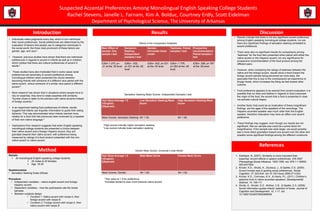
Senior Project
- 1. Suspected Accental Preferences Among Monolingual English Speaking College Students Rachel Stevens, Janelle L. Farnam, Kim A. Bolduc, Courtney Erdly, Scott Eidelman Department of Psychological Science, The University of Arkansas Introduction Sample 40 monolingual English speaking college students 20 males & 20 females Age: 18-25 Questionnaires • Sensation Seeking Scale (SScat) Procedure • Independent variables – native english accent and foreign hispanic accent • Dependent variables – how the participants rate the bread samples • Between-subjects design • Conditon 1: Native accent with recipe A, then foreign accent with recipe B • Condition 2: Foreign accent with recipe A, then native accent with recipe B Method Results References Discussion • Results indicate that there is not any significant accent preference among English speaking monolingual college students, nor are there any significant findings of sensation seeking correlated to accent preference. • There were also no significant results for comparisons among “tastiness” for the food item presented when paired with either the native accent or the Hispanic accent; nor any significance for prospective recommendation of the food product among the different pairs. • However, when comparing the ratings of tastiness between the native and the foreign accent, results show a trend toward the foreign accent sample being perceived as more tasty. We speculate that this is due to the overexposure we experience to foreign foods, which increases the liking we feel toward other cultures. • Food preference appears to be exempt from accent evaluation; it is possible that our likes and dislikes in regards to food overpower the origin of the food; the accent that a food is presented in does not activate cultural biases. • Another factor that could be an implication of these insignificant findings are the ages of the speakers of the recordings. The Hispanic accented speaker was much older than the English speaker, therefore maturation may have an effect over accent preference. • These findings may suggest, even though our results are not significant, that our sample size could be a prime factor for insignificance. If the sample size were larger, we would possibly see a more direct gravitation toward one accent over the other and possibly some significant findings among the different constructs. • Individuals make judgments every day, which in turn reinforces their social preferences. Social preferences are determined by the evaluation of factors that people use to categorize individuals in the social world; the three most prominent of these factors are gender, age, and race.2 • However, previous studies have shown that there are instinctual preferences in regards to accent in infants as well as in children, which implies that there are cultural preferences of accent in adults.2 • These studies have also implicated that in some cases racial preferences are secondary to accent preference among monolingual children when presented the choice between becoming friends with someone of a different race paired with the same accent, versus someone of a similar race paired a different accent.2 • More research has shown that in situations where people have to rely on expertise, they tend to relate expertise with similarity. Tourists chose to listen to the advisors with native accents instead of foreign accents.1 • In an experiment testing food preferences of infants, results suggest that infants use linguistic information to guide their eating behavior. This was demonstrated when infants reached more reliably for a food that had previously been endorsed by a speaker of their own native language.4 • Implications from research suggests that when English speaking monolingual college students are presented a choice between their native accent and a foreign Hispanic accent, they will gravitate towards their native accent; with preference being measured by ratings of a food product presented with the non- native accent or native accent. Main Effect of sample: One sample t test Sensation Seeking: Independent samples t test Gender: Univariate linear model Tastiness: Paired samples t test Prospective recommendation: Paired samples t test t(39)= 1.275, p= .21 at the .05 level t(38)= -.632, p=.531 at the .05 level t(38)= .632, p=.531 at the .05 level t(39)= -1.778, p=.083 at the .05 level t(39)= .298, p=.767 at the .05 level Effects of the Comparative Analyses Test Value Average 1.5 1(English) 2(Spanish) Low Sensation Seeking Mean Score High Sensation Seeking Mean Score Mean Scores: Sensation Seeking M= 1.55 M= 1.65 Test Value Average 1.5 1(English) 2(Spanish) Male Mean Score Female Mean Score Mean Scores: Gender M= 1.65 M= 1.55 Sensation Seeking Mean Scores: Independent Samples t test *High scores indicate higher sensation seeking *Low scores indicate lower sensation seeking Gender Mean Scores: Univariate Linear Model *Test value at 1.5 for preference *Females tended to lean more towards native accent 1. Dahlback, N. (2007). Similarity is more important than expertise: Accent effects in speech preferences. CHI 2007 Preceedings-Social influence, 1553-1556. doi: 978-1-1-59593- 593-9/07/004 2. Kinzler, K D., Shutts, K., DeJesus, J., & Spelke, E.S. (2009). Accent trumps race in guiding social preferences. Social Cognition, 27, 623-634. doi:10.1521/soco.2009.27.4.623 3. Kinzler, K.D., Corriveau, K.H., & Harris, P.L. (2011). Children’s selective trust in native accented speakers. Developmental Science, 14, 106-111. 4. Shutts, K., Kinzler, K.D., McKee, C.B., & Spelke, E.S. (2009). Social information guides infants’ selection of foods. Journal of Cognition and Development, 10, 1-17. doi: 10.1080/15248370902966636